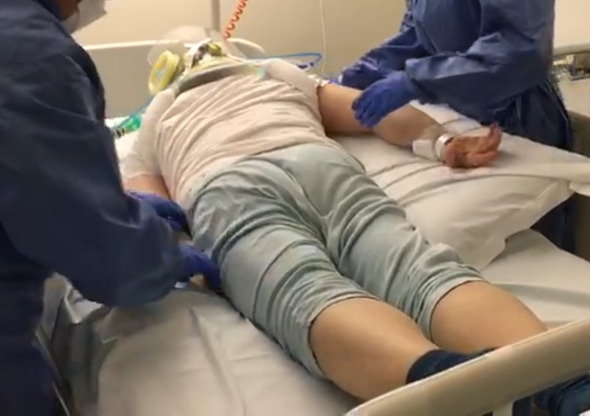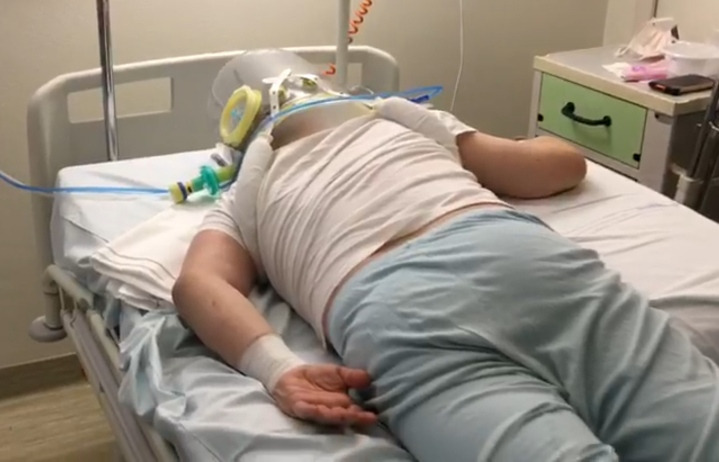Abstract
We report the experience of prone ventilation in selected patients treated with helmet non-invasive ventilation (NIV) continuous positive airway pressure (CPAP) for acute respiratory failure in COVID-19 pneumonia. Preliminary results showed an improvement in the PaO2 value and PaO2/FiO2 ratio after 1 hour of prone ventilation. No variation of the lung ultrasound pattern before and after prone ventilation has been detected. At the time of writing, we attempted proning with helmet NIV CPAP in 10 patients. In 4 out of 10 patients, the attempt failed due to lack of compliance of the patient, scarce pain control even with ongoing treatment and refusal by the patient to prone positioning.
Keywords: acute care, SARS, infectious diseases, viral, respiratory, pneumonia/infections, ventilation, non invasive
Introduction
Since its detection in humans in January 2020, the COVID-19 has spread worldwide and was declared a pandemic on 11 March 2020 by the WHO.1 2
Since the detection of the first Italian case of COVID-19 on 20 February, Italy has suffered from a rapid daily rise in the number of patients with COVID-19, particularly in the northern regions. At the time of writing, 101.739 COVID-19 cases and 11.591 deaths have been registered. In 1 month, our hospital, located in Piacenza, has diagnosed 2.516 COVID-19 cases, and 1.414 out of them needed hospital admission due to acute respiratory failure and 210 were eventually admitted to intensive care unit (ICU). Although the local health system responded vigorously, tripling the number of ICU beds, and carrying out the conversion of several wards to ‘COVID-19 units’, the high number of patients with COVID-19 admitted to our ED challenged the emergency physicians to find the way to deliver the best care possible to each patient, based on limited human and technical resources. Consequently, we developed a strategy to ameliorate respiratory distress in patients who were waiting for ICU. At the time of writing, only one pilot study has addressed prone positioning in non-invasive ventilation (NIV) continuous positive airway pressure (CPAP) during COVID-19 pandemic in the ED.3 Starting from the observation that pronation in intubated patients is indicated for 16–19 hours/day with significant improvement of respiratory function,4 we decided to attempt proning the patients with COVID-19 admitted to our ED for acute respiratory failure and treated with NIV with StarMed helmets. We assessed the effects of pronation in terms of improvement of the PaO2/FiO2 ratio and point-of-care lung ultrasound (US) signs.
Patient selection
Among all the patients admitted to our ED for acute respiratory failure, we selected patients who could be suitable for proning following these inclusion criteria: (1) the case was not considered for rapid intubation and ICU admission by the intensivist in charge; (2) the case was receiving helmet NIV CPAP without sufficient improvement of arterial gas exchanges; (3) the patient was awake and collaborative; (4) the patient was not considered to have an end-stage comorbidity that prevented any sort of therapy escalation following the guidelines issued by SIAARTI (Italian Society of Anesthesiology and Intensive Care) and adopted by our ED as a protocol to start palliation.5
Experience of the proned patients
We selected 10 patients (8 males and 2 females, mean age 73) as candidates for prone positioning. Demographic and laboratory findings are reported in table 1. The attempt failed due to lack of compliance in one patient (sliding and moving in lateral position), inadequate pain control even with ongoing treatment in one patient and refusal by two patients to prone positioning.
Table 1.
Patient characteristics
| Demographics | |
| Subjects (n) | 10 |
| Sex (M/F) | 8/2 |
| Mean age (years) (min–max) | 73 (62–87) |
| Laboratory findings | Median value (IQR) | Normal range |
| White cells (×10⁹/L) | 8.87 (6.08–9.63) | 4–10 |
| Neutrophils (×10⁹/L) | 7.64 (4.21–8.25) | 2–8 |
| Lymphocytes (×10⁹/L) | 0.98 (1.05–0.30) | 1.5–4 |
| Platelets (×10⁹/L) | 224.5 (177.0–266.75) | 150–450 |
| Creatine (mg/dL) | 1.10 (0.87–1.16) | 0.6–1 |
| LDH (U/L) | 540.5 (444–687) | 0–247 |
| AST (U/L) | 55 (44.5–82.0) | 10–31 |
| ALT (U/L) | 35 (18.75–66.5) | 10–31 |
| PT ratio | 1.15 (1.08–1.17) | |
| CRP (mg/dL) | 17.16 (12.81–18.75) | 0–0.5 |
Laboratory tests are expressed as median values and IQR.
ALT, alanine transaminase; AST, aspartate transaminase; CRP, C-reactive protein; F, female; LDH, lactate dehydrogenase; M, male; PT, prothrombin time.
Six patients (five males and one female) completed a cycle of prone ventilation. Their complaints included fever plus other clinical manifestations, including alterations of taste and smell, syncope, diarrhoea, vomiting or dry cough, for a median of 8±5 days. Every patient had a positive nasopharyngeal swab for COVID-19.
All the patients had peripheral capillary oxygen saturation (SpO2) less than 90% on room air, with tachypnoea (RR >22 breaths per minute). Only two had fever (body temperature >37.5°C). Four patients had cardiovascular comorbidities. All the patients had laboratory findings as reported in COVID-19 infection,1 such as lymphocytopenia, increased aspartate transaminase, elevated lactate dehydrogenase and C-reactive protein (table 1). Lung US showed B lines, pleural line irregularities in most fields and spared areas bilaterally. In all the cases high-resolution CT confirmed interstitial pneumonia ranging from 25% to 70% of lung parenchyma involved.
Initially, we provided oxygen to the patients via high-flux reservoir mask, but after a temporary improvement in SpO2 values, we observed a further worsening of the respiratory failure with persistent dyspnoea. An ICU bed was not available. For this reason, we started NIV CPAP via StarMed helmet with an FiO2 of 100% and a positive end-expiratory pressure ranging from 10 to 20 mm Hg. After a median time of 19 hours in NIV CPAP, all the patients developed severe hypoxaemia with a median PaO2/FiO2 ratio of 68±5 mm Hg.
We put the patients in a prone position with the help of specialised nurses (video 1). The patient was initially put supine on the border of a two-point movement bed with a water antidecubital mattress. A pillow was slid laterally under the chest and abdomen and the patient was prepared for turning with one arm on his abdomen and a leg crossed over the other. The nurses then slowly rolled the patient into a prone position and adjusted the helmet and the position of the head and arms (figures 1 and 2). The physician checked the helmet and the NIV pressures to verify the compliance of the patient with the procedure. In order to increase the compliance to NIV and reduce the anxiety linked to the situation, a continuous morphine infusion of 20–30 mg/day was started, which improved the patient’s compliance. After 1 hour of proning at the above settings, ABG showed an improvement in PaO2/FiO2 ratio for all the patients (median 97±8 mm Hg). Lung US after 1 hour of prone position showed no differences in B line quantity and distribution.
Video 1.
Figure 1.

Proning in non-invasive ventilation (NIV).
Figure 2.

Prone position.
At the time of writing, all the six patients eventually were admitted to ICU and underwent cycles of proning during invasive endotracheal ventilation. Patient 1 has been recovering in a rehabilitation ward with low-flow nasal prongs; patients 2, 3, 4 and 5 were moved to other ICUs outside Piacenza province to make new beds available; patient 6 died. Among the patients who did not receive prone NIV, patients 7, 9 and 10 died. Patient 8 recovered after a period of time in ICU.
In comparison to the study of Caputo et al,3 our cohort of patients are older and with a longer stay in the ED. Also, our patients had already been assessed by an intensivist and considered not to be admitted to ICU straight away. We decided to attempt proning in order to try everything possible to help these awake and compliant patients with severe respiratory failure in a crowded ED who were waiting for an ICU bed to become available for them.
We are aware that our results are preliminary and further investigation will be required to confirm our observation. We may have failed to spot differences in lung US before and after proning, because we performed lung US too early to detect significant changes.
Based on our experience, we believe that prone NIV CPAP could be an option for patients non-responsive to traditional NIV CPAP with helmet from whom ICU care is not quickly available.
emermed-2020-209744supp001.pdf (173.8KB, pdf)
Acknowledgments
The authors thank all the personnel of the ‘Guglielmo da Saliceto’ Hospital’s Emergency Department for their hard work and complete dedication.
Footnotes
Handling editor: Ellen J Weber
Contributors: DB planned the study and submitted it. ED and TI provided help in collecting data and informed consent by the patients. VT recorded the video and took the images attached to this study. AV created the database and edited the table. AM provided help with ethical approval by local institution and article proof-reading. EP helped with writing and proof-reading the article and the table.
Funding: The authors have not declared a specific grant for this research from any funding agency in the public, commercial or not-for-profit sectors.
Competing interests: None declared.
Patient and public involvement: Patients and/or the public were not involved in the design, or conduct, or reporting, or dissemination plans of this research.
Patient consent for publication: Obtained.
Provenance and peer review: Not commissioned; externally peer reviewed.
References
- 1. Cascella M, Rajnik M, Cuomo A, et al. Features, evaluation and treatment coronavirus (COVID-19. StatPearls Publishing, 2020. [PubMed] [Google Scholar]
- 2. World Health Organization Top 10 mortality causes, 2015. Available: http://www.who.int/gho/mortality_burden_disease/causes_death/top_10/en/ [Accessed 29 Mar 2017].
- 3. Caputo ND, Strayer RJ, Levitan R. Early Self-Proning in awake, Non-intubated patients in the emergency department: a single ED's experience during the COVID-19 pandemic. Acad Emerg Med 2020;27:375–8. 10.1111/acem.13994 [DOI] [PMC free article] [PubMed] [Google Scholar]
- 4. Kallet RH. A comprehensive review of prone position in ARDS. Respir Care 2015;60:1660–87. 10.4187/respcare.04271 [DOI] [PubMed] [Google Scholar]
- 5. Bertolini G. [The SIAARTI consensus document on the management of patients with end-stage chronic organ failure. From evidence-based medicine to knowledge-based medicine]. Recenti Prog Med 2014;105:7–8. 10.1701/1398.15553 [DOI] [PubMed] [Google Scholar]
Associated Data
This section collects any data citations, data availability statements, or supplementary materials included in this article.
Supplementary Materials
emermed-2020-209744supp001.pdf (173.8KB, pdf)


